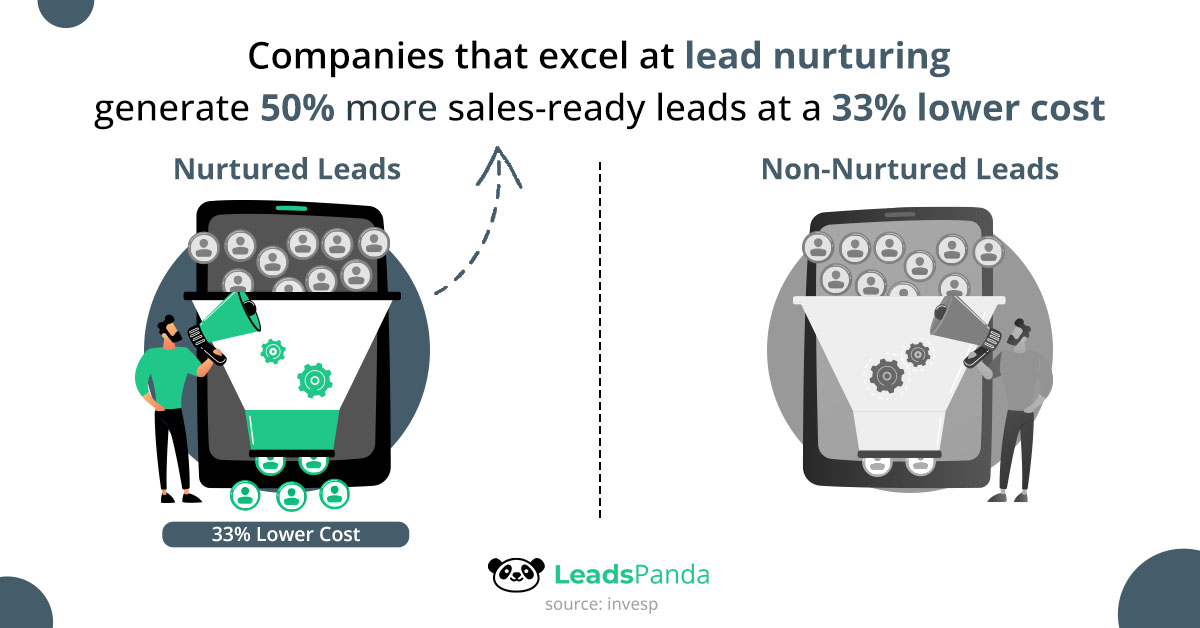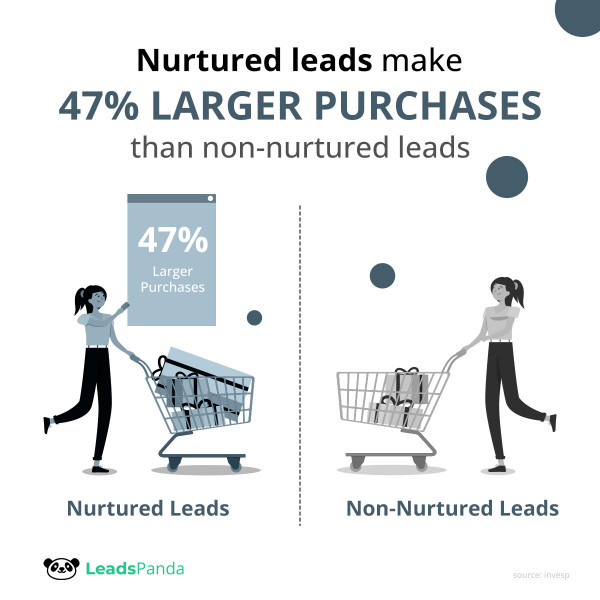5 Simple Steps To Craft the Perfect Lead Nurturing Campaign
Remember this:
No matter how loyal a customer is, no matter how many times they’ve previously purchased a product from you, and no matter how many times they’ve been to your website, they will inevitably have gone through bottlenecks before their interest actually became a sale. At any given time, 96% of people in your sales funnel aren’t ready to buy yet.
These bottlenecks are the challenges your customer experiences before they move on to the next step in the buyer’s journey. Your lead nurturing campaign is intended to address these challenges and convert these prospects into actual sales.

What is Lead Nurturing?
Lead Nurturing Is Not Just About Selling
While sales are the ultimate objective, lead nurturing is meant to help customers understand how your brand, product, or service can solve a problem they’re experiencing. It’s the process of identifying what you have to offer and how you can express the value of that product or service to the people you hope will pay for it.
Lead Nurturing Uses Email As a Primary Medium
There are multiple tools used today to nurture leads but email is still the most common and the most effective. Automation makes it easy to personalize messages to every type of customer so you can meet them where they are in the buying journey.
Lead Nurturing Requires Businesses to Give Away Something of Value
You need to prepare something that is highly valuable and relevant to your audience to capture the attention of your target market. There are no shortcuts here—only true value will work.
Now, with these in mind, let’s go into the steps you need to craft the perfect lead nurturing campaign.
How to Create a Perfect Lead Nurturing Strategy
1. Decide What To Sell
The first step to creating a lead nurturing campaign is determining what specific product or service you will focus on. If your business offers multiple services or different products, start with your hero product.
2. Identify Your Target Audience
The next step involves getting to know your audience, which is key if you want to position your product as something highly relevant to your audience. Consider how your product will solve a problem they are having. For instance, we’re a content marketing agency that offers content development as a hero product. Our core audience is mostly brand managers or private businesses. Knowing this means we’re able to clearly define what services we can offer that they will need and appreciate.
3. Based on Your Target Audience, Map Out Common Challenges They May Have in the Buyer’s Journey
Connect with team members who have direct contact with your customers. If you have a sales team or a frontline sales team who directly interact with customers, it’s best to brainstorm this step with them.
Once you have everyone gathered, list the frequently asked questions you get about your product or service. Identify typical challenges or pain points these questions reveal that might prevent a shopper from completing a purchase.
It’s critical to get straight to the point and be very honest about the concerns you encounter. Typical questions can include “How much does this cost?” and “How quickly do we see results?” A more uncomfortable question would be, “Why is your product or service so expensive?”
Once you have the questions, brainstorm with your team to answer them.
4. Segment Your Audience
Armed with your pain points and your audience information, you now have an opportunity to tailor your communications for better results.
Every customer will find themselves at various stages of the buying process. For example, at LeadsPanda, we often encounter:
- Brand managers who are already convinced that they need a content marketing agency but aren’t sure they’re willing to pay the cost of an external creative partner.
- Brand managers who are still exploring the idea of whether or not they need a content marketing agency at all.
It’s clear that nurturing these two types of customers will require different approaches, different communications, and different solutions.
For example, in the first segment, we need to focus on building real value behind our services to justify our cost. This means highlighting the return on investment in terms of both time and money.
In the second segment, we need to focus on introducing the prospective customer to the conveniences they can enjoy when they don’t have to worry about running and managing content for their organization.
5. Think About What These Segments Value
The final step is deciding what you can offer that will usher the lead further along the buyer’s journey. Again, this will vary greatly per client segment—but let’s take the first as an example.
We know that this group understands the value of a content marketing agency. We also know that they find the cost of our services prohibitive.
Assuming we have their email addresses and can send them emails, our next step would be to inform them about the ROI our services typically provide. We can send an email with infographics that highlight important statistics about savings incurred and media values generated, and our call to action can be a free trial.
Customers who click on our free trial can then be passed on to our sales team, who can coordinate their trial service and provide a one-to-one explanation of the benefits of our service.
Recipients who ignore the free trial offer can be sent a follow-up email a few days later, where we can discuss another pain point and explain how we can help. For example, are they feeling overwhelmed by the time it takes to develop content for their brand? We can help.

The great thing about these steps is that you can easily replicate them across the different stages of the customer journey and across your various segments.
If you want to learn more, reach out to us. Book a consultation or get started with LeadsPanda to find out how we can help you.
For any questions, leave a comment below or check out our LinkedIn or Twitter—and feel free to share a link on your social media channels.
Share This Story
Get the latest growth ideas, strategies, and best practices delivered to your inbox.
Quick read that helps 7000+ subscribers.








